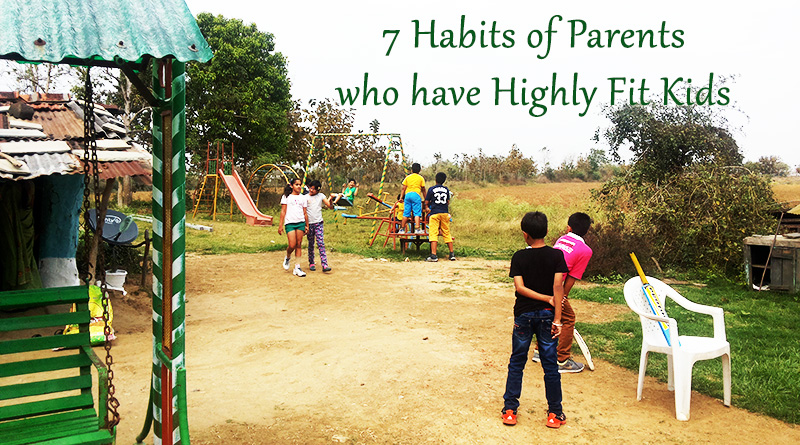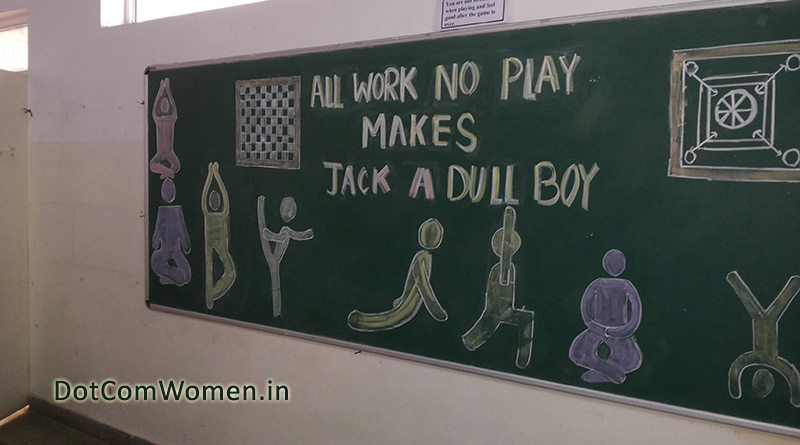It is getting increasingly difficult to keep kids fit and active in our age of mobile phones, Xbox, Playstation, computers games and TV. Busy parents, unwillingly, succumb to the engaging powers of these in order to make some much needed time for themselves. Sunday night pizza and food-ordering apps only make things worse. And so do the commercial ads promoting sugary breakfasts and junk food.

Inactivity in Kids
I fell into the vicious trap myself and noticed my kids getting lethargic and bulky. I started seeing a number of red signals including:
- Weight Gain
- Decreased performance at School
- Low Resistance to Diseases
- Pale Skin
- Bad moods
- Low self esteem
- Negative body image (even in preschoolers!)
Determined to change the scenario, I looked around myself to find inspiration from other parents whose kids were much more fit and active. Taking cues from them and working them around to the likes and tastes of my children, I came up with these seven habits for parents who want their kids to be fit and active.
7 Habits to Make Kids Fit and Active
1. Integrate Physical Activity in the Daily Family Chores
Just like you encourage the family eating and praying together, make it a habit to do some physical activity together. A walk in the morning or post-meals is a wonderful idea. Another idea that works perfectly is cleaning/washing your vehicles. While mom and dad wash their cars, set up with their own cleaning buckets and cloth wipes and ask them to clean their bicycles. Similarly, when doing household chores like washing the dishes, ask kids to wash their toys or wipe and arrange the dishes. You can also do a ’10 minute house cleanup’ where the kids pick up all their toys and clean their tabletops etc. while you straighten up some other room. If you love gardening, take the kids out with you and give them little tasks like carrying things back and forth, pulling out weeds, watering plants with their own toy watering cans. Don’t forget to thank them and let them know how the task was impossible without their help.
2. Limit Screen Time
Any screen, be it mobile phones, TV or computers – can be very addicting. Children under the age of two are advised against any kind of screen time. Limit the screen time to a maximum of two hours. This includes all kinds of screens used throughout the day. Do not let the children have a screen in their own room unless they are mature enough. Place the TV and computer in a publicly accessible area in your house where you can monitor its use. Late night texting, chatting or browsing must be discouraged as it affects sleep.
Take the first step in actively searching interesting and educational websites and games for your kids to enjoy. After they are done playing the game or browsing the internet, talk t them about what they learned or liked about it. If they watch any ‘how to’ videos on YouTube, encourage them to out the knowledge to use. If necessary, sit down with them and help with the project. Always use parental control settings in every device your kids have access to. From safety settings to special browsers for kids, there is plenty you can do to keep your kids from being exposed to undesired content on the internet.
Make Screen Time Work!
If your kids are addicted to PlayStation or XBox, look for video games that promote activity. All such platforms have a number of games that involve getting up and dancing, sports or moving your hands and feet in some way or the other.
3. Enroll Kids in Sports
India has is having its ‘Sports’ moment and there is no better time to jump in. New sports centers and stores are coming up every day. On one hand, racquet sports like Badminton and Tennis and team sports like Cricket and Football are big. On the other hand, people are taking up everything from Archery to Gymnastics It is the perfect time to introduce your children to a variety of sports. It is always a good idea to let them experience different types to see what they like best. Pushing them too hard towards any one can make them insecure of under-performing and disappointing you. Exposure to different sport activities will also help them develop many different skill sets.
Children under the age of 5 years do not understand game rules and are often not coordinated enough to participate in organized sports. They will enjoy swimming, dancing, throwing, catching etc.
4. Encourage Active Play Time

A health themed exhibition in my son’s school reminded visitors of the age old proverb that holds true.
Organized sports alone are not enough to keep children and adolescents healthy and fit. Fit kids are active, not only on the field, but in their everyday lives. Encourage kids to go out and play actively. The daily playtime activities of every child should include 4 types of activities”
- High Intensity – These are generally activities that make them sweat and make them feel ‘out of breath’. Examples would be energetic games that involve running, fast cycling, fast swimming, hiking, skipping rope, martial arts etc.
- Moderate Intensity – These activities also result in sweating but the child is able to talk between them. Examples are fast walking, roller skating, skateboarding, cycling at a moderate pace etc.
- Muscle Strengthening – Games like ‘tug of war’ and climbing (safely, of course) help strengthen muscles.
- Bones Strengthening – Playtime activities like skipping rope, jumping, hopscotch (thikkar-billa) help strengthen bones.
5. Replace Family ‘Eating Out’ with Other Activities
Treating the kids to a chocolate doughnut or ice cream has become the norm of modern Indian families. Pizza, burgers and noodles are alternate dinners as well as a great way to take the kids out for a fun evening. Another favorite is to spend a thousand bucks on movie tickets and overpriced popcorn. But guess what? Smart parents of physically fit children have other ideas for fun evenings out with the family. They bring back old-fashioned picnics and take the kids to nearby parks. After the kids have had their fill of the swings and slides, the families indulge in old-fashioned fun like blind man’s buff, badminton and frisbee with easy and filling homemade snacks like sandwiches and popcorn along with fresh fruits. Water chestnuts and groundnuts never taste better than when enjoying a family picnic in the park.
You could also spend Sundays driving to a picnic spot near your city. When in the city, take the kids to a play zone in the malls where they can jump in the bouncy castles and enjoy activities like bowling. You can also take them to the local market on Sunday morning to see how fresh vegetable, fruits and flowers are sold. This will enrich their general knowledge while making them walk without even realizing it. A visit to the local museum, science center, farm or orchard is also a fun activity that does not involve eating unhealthy food and promotes physical exercise.
6. Healthy Eating
This is easier than it sounds. You do not need to deprive them of their natural diet – only remove the unhealthy junk foods. Slowly and smartly, change the children’s diet by cutting off junk and expanding their taste buds. Hide new and healthy vegetables in parathas and tikkis. Add dry and fresh fruits to their breakfast. Make them finish an extra katori of ‘daal’, if you can. Add different pulses to dosas and cheelas. Plan their tiffins a night before so you do not give them anything unhealthy due to lack of time in the morning rush.
The evening snack posed the biggest challenge for me. Working moms will find this forever challenging but it is not exactly impossible. While it seems easy to hand them chips and cream biscuits to satiate them between lunch and dinner, you know very well it does more harm than good. A chapati rolled up with jam or a chocolate spread might be better than chips but you can do better than that. Keeping Dosa batter ready in the fridge can be a saviour. When you can think of nothing else, a glass of milk with some cereal to go with it, is a great choice. In your absence, older kids can manage to pour their own milk and even make a cheese sandwich if you can stock whole wheat or multi-grain bread and cheese slices. Fresh fruits are easy to stock and serve and even younger kids can manage to eat a banana on their own. When you are at home, add some chopped veggies to readymade soup mixes for a nutritious snack. Masala oats and nutrition bars also make good anytime snacks.
7. Set an Example
Maybe I exaggerated when I said the evening snack was the biggest challenge. The real challenge lies right here, I guess. Kids love to imitate you. Nothing can teach them better than your own actions. Here are some things that you are going to need to change.
Take note of your own ‘screen time’ and revise if necessary.
Take the initiative to skip the car and walk or bike to some places especially when the kids are with you.
Involve kids in any physical activities you enjoy. I drag the kids to do Yoga with me or turn on the radio and begin dancing with them. My husband has recently taken up cycling and this has motivated the kids immensely.
Take the stairs instead of an escalator or elevator.
Control your portions and exclude high-sugar and high-fat snacks entirely from the pantry. Learn to live without them and find healthy replacements. It is easier when the unhealthy options are out of sight and unable to tempt the kids.
Control the number of times you ‘eat out’ or ‘order in’.
There you go! I am trying to make these habits a part of my lifestyle now and always. And is it working? Of course, it is! From body image and school grades to their BMI and resistance to diseases, everything is improving. Touch wood!




Leave a Reply